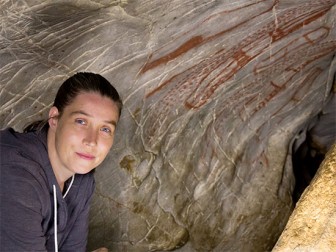What Were They Thinking? Cracking the Cave Art Code
Monday is “Darwin Day,” the anniversary of the birth of Charles Darwin, the British naturalist who changed how humans understand the living world. Cave-art researcher Genevieve von Petzinger last week spoke at The University of Alabama at Birmingham to help mark the occasion. Von Petzinger studies geometric patterns found in caves all over Europe. As she tells WBHM’s Dan Carsen, in college she’d excavated Roman artifacts … but that wasn’t quite right for her. A few highlights:
Von Petzinger decided Roman artifacts weren’t old enough. “Which sounds really funny, right? Something 2,000 years old was too young. But I was like, this already feels like things have happened. I’m more interested in the origins of things. So I study some of the oldest art in the world — the art from caves in Europe from the Ice Age, between 10,000 and 40,000 years old.”
It’s Not Just the Deer and the Spears
“What fascinates me are the little squiggly marks, what we call the geometric signs — is there a pattern? Are they repeating them? How many signs are there? And, you know, do the same ones appear across space and time? Can we figure out things with them? And the answer is yes.”
The Signs that Repeat
“We have 32 signs, which is actually a very small number, that repeat at caves all across Europe for like 30,000 years … I think what we’re probably dealing with is some important ideas or concepts, almost like putting the one word on the wall as opposed to the whole sentence … what I’m digging into now is I think a thematic level: we might be able to start saying, “maybe this is a weapon, or maybe this is their house.”
Cave Wall, Window, and Computer?
“It’s a really unusual window into their minds. This is like trying to understand how they’re making sense of the world around them. And doing something like making graphic marks is actually a very mentally sophisticated thing to do because they’re actually storing information outside their body, which sounds funny but, I mean, what is a computer? So it’s that mental shift to understanding that information isn’t just in your head, or in your verbal words, but that you can actually store it and share it — a hugely important concept.”
Neanderthal Lineage
“We used to think that Neanderthals and humans weren’t related. And then we’ve realized now that they’ve interbred. And according to my genome, I’m almost 4 percent Neanderthal on my mother’s side. So there we go.”
Web Extra: Cave Art in Pop Culture
Genevieve von Petzinger’s thoughts on the film Prometheus, in which cave art figures prominently:
Pipe bomb suspect told FBI he targeted U.S. political parties, memo says
The man accused of placing two pipe bombs in Washington on the eve of Jan. 6, 2021 told investigators someone needed to "speak up" for people who believed the 2020 election was stolen, prosecutors said Sunday.
Chinese military stages drills around Taiwan to warn ‘external forces’
The drills came after Beijing expressed anger at U.S. arms sales, and a statement by Japan's prime minister saying its military could get involved if China were to take action against Taiwan.
Trump and Netanyahu to meet in Florida at a crucial moment for the Gaza ceasefire
President Trump could use the face-to-face at his Mar-a-Lago estate to look for ways to speed up the peace process, as Israel's leader has been accused of not pushing his side to move fast enough.
‘Bomb cyclone’ forecasted to bring heavy snow, blizzard conditions and dangerous travel
A 'bomb cyclone' is intensifying severe winter weather for millions of people across the U.S. The system is expected to knock out power and disrupt holiday travel.
Russia sends 3 Iranian satellites into orbit, report says
The report said that a Russian rocket sent the satellites on Sunday from a launchpad in eastern Russia.
Viral global TikToks: A twist on soccer, Tanzania’s Charlie Chaplin, hope in Gaza
TikToks are everywhere (well, except countries like Australia and India, where they've been banned.) We talk to the creators of some of the year's most popular reels from the Global South.








